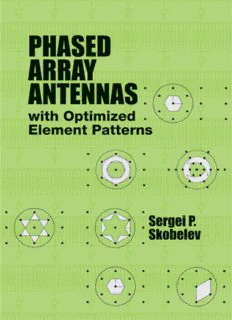
Phased Array Antennas with Optimized Element Patterns PDF
Preview Phased Array Antennas with Optimized Element Patterns
Phased Array Antennas with Optimized Element Patterns For a list of recent related titles in the Artech House Antennas and Propagation Series, please turn to the back of this book. Phased Array Antennas with Optimized Element Patterns Sergei P. Skobelev artechhouse.com Library of Congress Cataloging-in-Publication Data A catalog record for this book is available from the U.S. Library of Congress. British Library Cataloguing in Publication Data A catalogue record for this book is available from the British Library. ISBN-13: 978-1-60807-190-6 Cover design by Vicki Kane © 2011 ARTECH HOUSE 685 Canton Street Norwood, MA 02062 All rights reserved. Printed and bound in the United States of America. No part of this book may be reproduced or utilized in any form or by any means, electronic or mechanical, includ- ing photocopying, recording, or by any information storage and retrieval system, without permission in writing from the publisher. All terms mentioned in this book that are known to be trademarks or service marks have been appropriately capitalized. Artech House cannot attest to the accuracy of this informa- tion. Use of a term in this book should not be regarded as affecting the validity of any trade- mark or service mark. 10 9 8 7 6 5 4 3 2 1 To my sons Sergey and Alexey Contents Preface xi Introduction xiii ChAPtEr 1 General Concepts and Relations 1 1.1 Basic Characteristics 1 1.1.1 Element and Array Radiation Patterns 1 1.1.2 Array Factor 2 1.1.3 Directivity, Gain, and Efficiency 5 1.2 Infinite Array Model 6 1.2.1 Quasi-Periodic Excitation 6 1.2.2 Aperiodic Excitation 9 1.3 Ideal Element Pattern 12 1.3.1 The Highest Level 12 1.3.2 Contours of the Ideal Element Pattern 14 1.3.3 Element Gain on Ideal Contour 16 1.3.4 Ideal Element Efficiency and Mutual Coupling 17 1.3.5 On Realizability of the Ideal Contour Element Pattern 20 1.3.6 Properties of Orthogonality 23 1.4 Element Pattern with Nonideal Contour 26 1.5 Minimum Number of Controlled Elements 28 1.5.1 Formulation 29 1.5.2 Element Use Factor 30 1.6 Two-Dimensional Problems for One-Dimensional Periodic Structures 32 1.6.1 Fields at Quasi-Periodical Excitation 32 1.6.2 Excitation of One Array Input 35 1.6.3 Ideal Array Element Characteristics 36 References 41 Appendix 1A Array Element Gain on the Ideal Contour 45 Appendix 1B On the Forming of Orthogonal Beams by a Planar Aperture 47 Appendix 1C O n the Efficiency of a Dense Array Shaping a Contour Radiation Pattern 52 ChAPtEr 2 Arrays with Beam-Forming Networks 55 2.1 Overview of Technical Solutions 55 2.1.1 Array Based on Butler Matrices 55 vii viii Contents 2.1.2 Network of J. T. Nemit 56 2.1.3 Network of R. J. Mailloux and P. R. Franchi 57 2.1.4 Network of R. F. Frazita, A. R. Lopez, and R. J. Giannini 58 2.1.5 Network of E. C. DuFort 59 2.2 Multicascaded Chessboard Network 60 2.2.1 Analysis of the Radiation Characteristics 61 2.2.2 Statement and Solution of the Synthesis Problem 64 2.3 Experimental Study of the Chessboard Network 67 2.4 A Linear Array with Chessboard Network as a Feed of a Parabolic Cylindrical Antenna 70 2.4.1 Formulation of the Problem 71 2.4.2 Highest Possible Antenna Gain 76 2.4.3 Results, Comparison, and Discussion 76 2.5 Quasioptical Analogs of the Chessboard Network 80 2.5.1 Features of the Array Geometry 81 2.5.2 Subarray Pattern 83 2.5.3 Results of Calculations 84 References 86 ChAPtEr 3 Arrays of Coupled Dual-Mode Waveguides 91 3.1 A Simplified Model 91 3.2 An Improved Model for Scanning in E-Plane 96 3.2.1 Array Geometry and Excitation 96 3.2.2 Mathematical Model 96 3.2.3 Highest Characteristics at Dual-Mode Excitation 98 3.2.4 Optimization of the Structure 101 3.2.5 Numerical Results 101 3.3 Array Structure for Scanning in H-Plane 104 3.3.1 Features of Geometry and Optimum Excitation 104 3.3.2 Computed Array Characteristics 106 3.4 Experimental Study of the H-Plane Array 109 References 111 Appendix 3A Calculation of the Scattering Matrix Elements for the Slots in Waveguide Walls 113 Appendix 3B Analysis of the Modified H-Plane Array Aperture 115 ChAPtEr 4 Arrays with Reactively Loaded Radiators 121 4.1 On Application of Reactive Loads in Array Antennas 121 4.2 Modulated Corrugated Structure Excited by Electric and Magnetic Currents 123 4.2.1 Quasi-Periodic Excitation 124 4.2.2 Radiation Pattern at Local Excitation 130 4.2.3 Shaping of Sector Radiation Pattern 131 Contents ix 4.3 Modulated Corrugated Structure with Active Waveguides 134 4.3.1 Analysis and Synthesis 135 4.3.2 Calculated and Measured Results 137 References 139 ChAPtEr 5 Waveguide Arrays with Protruding Dielectric Elements 143 5.1 Waveguide-Dielectric Arrays and Structures 143 5.2 Overview of the Methods and Results 146 5.2.1 Mode-Matching Method 147 5.2.2 Incomplete Galerkin Method 147 5.2.3 Projective Resonator Method 148 5.2.4 Method of Surface Integral Equations and Method of Auxiliary Sources 148 5.2.5 Method of Integral Equations for Polarization Currents 149 5.2.6 Finite Element Method and Commercial Codes 150 5.3 Hybrid Projective Method in Two-Dimensional Problems (E-Polarization) 151 5.3.1 Array Geometry and Excitation 151 5.3.2 Representation of Fields 152 5.3.3 Projective Matching of the Fields on the Boundaries 153 5.3.4 Application of the Finite Element Method 155 5.3.5 Algebraic System and Array Characteristics 157 5.3.6 Realization, Validation, and Numerical Results 158 5.4 Excitation of Array in TEM-Mode (H-Polarization) 162 5.4.1 Statement of the Problem and Representation of the Fields 162 5.4.2 Relations Resulted from Conditions on the Boundaries 164 5.4.3 Finite Element Method for H-Polarized Waves 166 5.4.4 Total Algebraic System 168 5.4.5 Realization of the Algorithm and Discussion of the Array Characteristics 169 5.5 Three-Dimensional Problem 176 5.5.1 Statement of the Problem and Fields in the Structure 176 5.5.2 The Hybrid Projective Method 180 5.5.3 Array Characteristics 185 5.5.4 Results and Discussion 186 References 190 Appendix 5A Explicit Expressions for Integrals (5.22), (5.23), and (5.24) 193 Appendix 5B Values of Integrals (5.119) 194 ChAPtEr 6 Arrays with Strip, Disk, and Wire Structures 195 6.1 Experimental Breadboard of Array with Multidisk Radiators 195 6.1.1 Breadboard Design 195 6.1.2 Results of Measurement 197
Description: